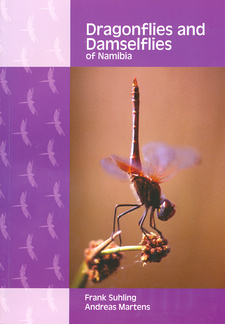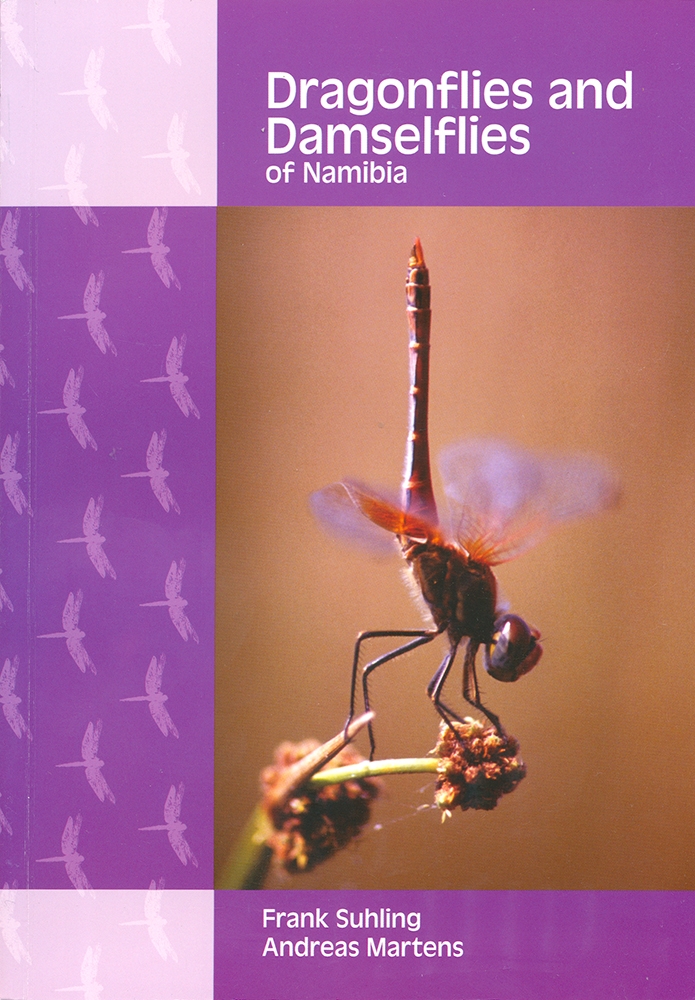Dragonflies and Damselflies of Namibia, by Frank Suhling and Andreas Martens

Dragonflies and Damselflies of Namibia, by Frank Suhling and Andreas Martens. Gamsberg Macmillan Publishers. Windhoek, Namibia 2007. ISBN 9789991607641 / ISBN 978-99916-0-764-1
How to use this field guide, Dragonflies and Damselflies of Namibia, by Frank Suhling and Andreas Martens.
Dragonflies and Damselflies of Namibia, by Frank Suhling and Andreas Martens, opens with a general introduction to dragonflies. The first two chapters, "What is a dragonfly?" and "Biology and ecology of Odonata", aim to establish the appearance of dragonflies, their ecology and their behaviour in general, with special reference to Namibian species. The third chapter deals with dragonfly habitats in Namibia and their assemblages. The reader is guided on where to find dragonflies in the country, and what their special habitat requirements are. The fourth chapter, entitled "Surveying dragonflies", introduces the reader to specific methods of recording these insects in respect of surveys or long-term monitoring. The field guide proper includes identification keys to and descriptions of the families, genera and species of adult dragonflies that occur in Namibia. The keys, which tabulate 150 species of dragonflies, include some species that have not yet been recorded in Namibia but which may occur here.
Jewels of the watershed
Dragonflies are fascinating insects. They belong to the insect order known as Odonata, of which about 6,000 species occur worldwide and about 880 in Africa. There is no doubt that dragonflies are among the most beautiful and interesting animals on earth. Adult dragonflies are aerial creatures with a superb ability to fly; the larvae develop in water and are critical with regard to water quality and aquatic habitat structure. Living in these two worlds, dragonflies are optimal indicators of wetland health. A full array of different ecological types, from pioneers to specialists, occurs within the Odonata. This allows habitat changes to be monitored on the basis of positive and negative indicators. Dragonflies are already used as indicators for wetland quality in many parts of the world. To use dragonflies this way requires secure identification. This is one of the aims of this field guide. Why study dragonflies in Namibia? Being the most arid country in sub-Saharan Africa, does Namibia even have a significant population of dragonflies? It indeed does. In fact, Namibia has almost 130 species of dragonflies, most of which occur in the more humid, tropical north. Compared with other tropical countries this may not be a high diversity, but it is about the same number of dragonfly species that occurs in Europe. So not only do a surprisingly high number of species occur in Namibia, there is also the phenomenon of the enormous swarms of millions of Wandering Gliders [Pantala flavescens] and some other species that enter the desert every year with the onset of the rainy season. Thus, dragonflies are of importance even in an arid country. [...]
This is an excerpt from Dragonflies and Damselflies of Namibia, by Frank Suhling and Andreas Martens.
Title: Dragonflies and Damselflies of Namibia
Authors: Frank Suhling; Andreas Martens
Publisher: Gamsberg Macmillan Publishers
Windhoek, Namibia 2007
ISBN 9789991607641 / ISBN 978-99916-0-764-1
Softcover, 15 x 21 cm, 280 pages, 174 photographs, 27 plates with line drawings and 125 distribution maps.
Suhling, Frank und Martens, Andreas im Namibiana-Buchangebot
Dragonflies and Damselflies of Namibia
A Guide to dragonflies and damselflies of Namibia featuring 174 photographs, 27 plates with line drawings and 125 distribution maps.

